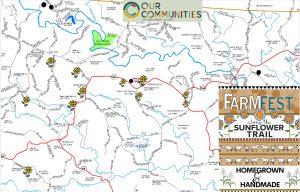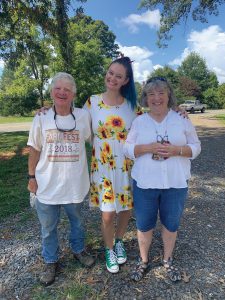Francisco Farmfest
Jessica Lawrence
Our community has been holding our annual Farmfest for a few years now, but last year was modified for the pandemic. We made it the Sunflower Trail instead, which minimized interactions, reduced liability, and gave people a more personalized experience. This year, the pandemic was still here enough that people felt more comfortable with the Sunflower Trail rather than the traditional Farmfest gathering. Everyone starts at the Fire Department and picks up a map that shows all the stops and has a description on the back. While each of us that is a mark on the map want to make some money selling our products or teach people with the demonstrations, the important part of Farmfest is interacting with the community.
As I have previously mentioned, I would like to park Lucy, the 1967 F100 indoors. The few thousand pieces of bee equipment seem to keep preventing me from doing that, so I thought maybe I’d sell some at really cheap prices during Farmfest to get rid of it and make space. What I got instead was selling maybe 30 pieces of bee equipment and spending most of the day talking to beekeepers. I also sold plants, but most of the plant people knew what they wanted, paid, and went on their way. The beekeepers, however, all wanted to discuss the current bee climate and their issues and all of the things beekeepers normally talk about.
This year there was definitely some themes among all the beekeepers and what they wanted to talk about. All of the problems this year are stemming from the fact that the fall flow was really a drizzly Summer sludge that didn’t do much and fizzled out in September, leaving the bees aggressive, hungry, and full of wax moths and hive beetles. I started feeding my girls pollen patties and sugar syrup in the beginning of September and they took every bit of it in a few days. Sometimes hive beetles can be a problem when feeding pollen, but that’s normally only the case if it is not consumed quickly. My Varroa counts weren’t too bad in August (average less than three per hive), but I treated with a round of Apiguard in mid-September, while throwing in pollen patties, sugar syrup, and doing a quick inspection. There weren’t really signs of wax moths or hive beetles in my hives, but they’ve been babied pretty well over the past couple months and seem happy. When I spoke to my beekeeper visitors, I tried to remember to tell them to do a 1:1 ratio that means weight to weight. I can easily put a 25 pound bag of sugar into a five-gallon Coleman water carrier but I do have to heat the water up.
The wax moths are an issue that most beekeepers see as the problem when it’s really a symptom. Of course, wax moths are the devil and will destroy stored frames if you don’t take care of them, but in a hive of bees they normally don’t move in unless the colony is already in a weakened state. Hive beetles are really underrated for the amount of damage they can do when left unchecked, but there’s not a lot that can be done about them other than telling your bees to be better sentries against beetles. What’s nice now is that at least for stored frames, Certan is allowed again for use after removing honey supers so at least you can prevent damage on wax for the next year. While Certan is a formulation of Bt, which is a bacteria that only attacks lepidopteran pests and is harmless to bees, it is not registered for use in a hive with bees. If I made Certan, I also wouldn’t register it for in-hive use because then you get beekeepers who kill their bees and blame Certan, and then the lawsuits start and you lose your company. There are plenty of options for purchasing this product online. This is the point in my column where I fall down the rabbit hole and off into a tangent. I would like to direct your attention to Amazon for this particular product description. In the top bulleted points, where you typically find a product description, we are all gifted with this glorious note from the seller:
“NOTE: CALIFORNIA has not approved B402 for use in honey bee hives. We CANNOT ship Certan B402 to CALIFORNIA. Don’t like that decision? Contact Jared Blumenfeld, Secretary for Environmental Protection at CalEPA | California Environmental Protection Agency. All other states and the District of Columbia have been approved B402 for use in honey bee hives by the EPA.”
This is one of the best pieces of marketing I have ever seen and I can only find it on Amazon. For anyone who spends much time on the internet, you know there are some gems when looking through products, descriptions, and reviews on the website. The fact that they used a specific contact is description GOLD and they clearly intend for beekeepers to be outraged by this and indeed contact Jared Blumenfeld. I could not tell you how much distress this description has caused Mr. Blumenfeld, but he has quite the biography on the CalEPA website. It appears that Mr. Blumenfeld took his position in 2019 and almost seems like a step down from his previous appointment as the EPA’s Regional Administrator for the Pacific Southwest during Barack Obama’s presidency. Most of his focus is on urbanization problems and does not list anything that could be an achievement or milestone with anything agricultural or rural. Surprisingly, it took me more than 10 minutes to find contact information. Some of that time was spent reading info on his personal website, on his podcast website, and on the CalEPA website. If you search it, you can get a phone number for Michelle Hutzel (916) 323-2515, but his email address, SectyBlumenfeld@calepa.ca.gov was a little harder to find. I will admit to more than a passing curiosity after the Amazon description just for the frustration it would take to put that at the top of a product page. It is not uncommon with pesticide product registrants to experience difficulty with California’s EPA to a higher degree than the US EPA. I have tried my best to stay out of California for as long as possible after spending so much time there in the past, so my curiosity only goes so far. Please write in to Bee Culture if any of you happen to contact Mr. Blumenfeld but please let me know if you used information I found, or if you found another means, and if you received a response. I would definitely be curious as to his beekeeper rhetoric and the rationale for not allowing a product to be registered that would not technically be labeled as an in-hive use pesticide or come into contact with bees, and has no history of toxicity or ability to be toxic to bees.

Besides wax moths, I am trying to stress to beekeepers that while feeding sugar syrup and having honey is definitely important to honey bee success, protein is critical and often overlooked. I will not argue with anyone who doesn’t want to make pollen patties because it’s a long process that makes a huge mess and gets everywhere (or is that just me?) and I totally understand why you wouldn’t want to do that. Pollen patties are also expensive if you buy them pre-made. I get it. With our fall flow this year, it is a pretty easy assumption that if the nectar flow is slowing down, the pollen is not likely to be pouring in either. My personal opinion is that this is the most critical time of the beekeeping cycle to ensure pollen availability in a colony. This is when your queen is going to start producing her Winter bees, who have an entirely different physiological makeup than the rest of the year. Availability of sufficient nutrients is essential to healthy production of the workers that will have to carry the colony’s legacy through the Winter. Hopefully there is something available in the local environment to sustain them and your pollen patty addition will just be a supplement. If you are not sure and you just don’t want to waste your time, make your pollen patties and feed them in half-doses. Check them again in a week and if there’s nothing left but a strip of wax paper, you can probably feed them a whole patty with no worries of hive beetle infestation or over feeding. Patties freeze pretty well if you want to mass produce a batch while you’re already destroying your kitchen or workspace. I personally prefer to make my own patties because I can add whatever I want to it, like Honey B Healthy or Brood Booster or an additional protein supplement. The danger of this is adding too much or making the wrong ratio and wasting your time because you made it repellent. Less is more with bees. Don’t waste your time or money in overdoing it with an additive. The premade patties are almost always a better consistency than my personally produced ones, but they’re usually thicker and I think my girls take thinner patties better. It’s really a matter of personal preference for the type of protein you give them, but please give them something. It is a bit of an investment, but your girls will overwinter a lot better if you keep them happy with protein and they’ll go a little faster in the Spring if you’re all about some splits.










